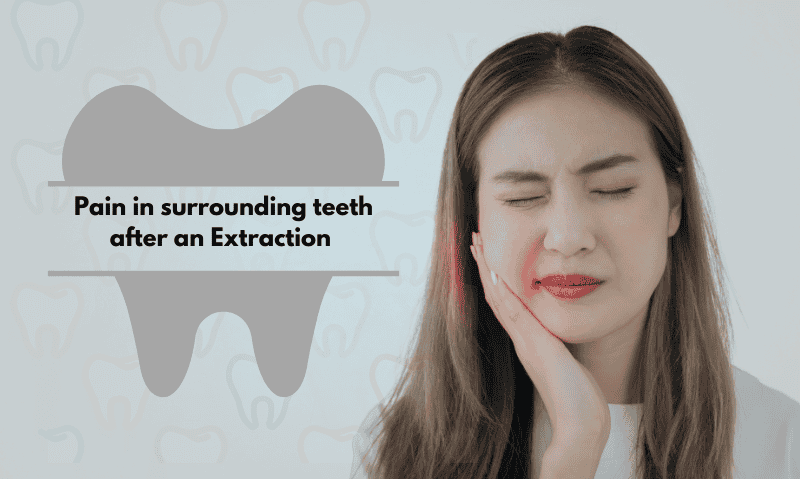
Experiencing pain in the surrounding teeth after an extraction site is a relatively common but discomforting issue that can arise after dental surgery. While tooth extractions are routine dental procedures intended to alleviate long-term oral health issues, they can occasionally lead to immediate postoperative complications, including pain in the surrounding teeth. Understanding the reasons for this type of pain is crucial for effective management and smooth recovery.
Causes of Pain in the surrounding Teeth
Pain in surrounding teeth after tooth extraction can arise due to various reasons
physical trauma: The adjacent tooth may suffer from direct impact or stress during extraction, potentially leading to micro-damages or increased sensitivity.
Increased Sensitivity: Exposed roots or nerves from the extraction can make the neighboring tooth sensitive to temperature changes, sweet foods, and other irritants.
Inflammatory Response: Swelling from the extraction site can extend to surrounding tissues, pressing against the adjacent tooth and causing discomfort.
Infection Spread: Bacteria from the extraction site can infect neighboring areas, resulting in pain and possibly more serious complications if untreated.
Bite Disruption from Tooth Extraction: Removing a tooth, especially a key molar, shifts the force distribution across your bite, increasing pressure on surrounding teeth. This change can cause initial discomfort, which generally eases as the teeth adapt to new positions.
Preventive measures to minimize pain in surrounding teeth?
Preventive measures can minimize the risk of pain in the surrounding teeth next to an extraction site. Here are some strategies that can be implemented:
Proper Extraction Techniques: Ensure the dentist uses precise and careful extraction techniques to minimize trauma to neighboring teeth and tissues.
Pre-Extraction Assessment: A detailed dental examination before extraction allows the dentist to identify and minimize any potential complications that could arise during or after the extraction.
Post-Extraction Instructions: patients should be provided with precise instructions post-extraction. This includes guidance on managing swelling, preventing infection, and the appropriate times to use ice or heat to aid recovery.
Regular Follow-Ups: follow-up appointments with the dentist to address any emerging issues promptly.
Good Oral Hygiene Practices: Maintaining excellent oral hygiene helps prevent infection at the extraction site and supports the health of adjacent teeth.
Use of Protective Dental Appliances: If grinding or clenching is a concern, consider using a mouthguard to protect adjacent teeth from excessive force.
when to seek help?
Serious Issues at Extraction Site need immediate help
Infection: Possible development within the Socket, leading to pain and irritation in the area where the tooth is removed. Treatment may include antibiotics and cleaning.
Dry Socket: causes severe throbbing pain after tooth extraction where the blood clot fails to form, exposing bone and causing discomfort. It is typically relieved within 14 days with proper treatment.
Tearing in the Gums: Minor tears heal naturally; substantial damage may require stitches.
Jaw pain after extraction
Jaw pain after tooth extraction is often related to the nature of the extraction procedure and the individual’s response to it. Here are some common causes
Trauma from the Procedure: Extracting a tooth can put a significant amount of pressure on the jaw, especially if the procedure is complex or the tooth is impacted
Inflammation is the body’s natural response to surgery, which helps heal but can also cause swelling and pain around the jaw area.
Dry Socket: Exposed nerves and bone within the empty tooth socket can cause severe jaw pain.
Infection: If bacteria enter the extraction site, it can lead to infection, characterized by persistent pain, swelling, redness, and possibly the emission of pus, all of which can extend to the jaw.
Prolonged Mouth Opening: During dental procedures, keeping the mouth open for a long time can strain the mastication muscles and TMJ joints, causing jaw pain after the procedure.
Nerve Damage: Although rare, nerve damage during tooth extraction can lead to acute jaw pain, numbness, or tingling sensations, depending on the affected nerve.
conclusion
Experiencing pain in the surrounding teeth after an extraction is a common, temporary issue during recovery. Recognizing the causes of this discomfort helps ease worries and assists in managing the healing process. If the pain continues or worsens, it’s important to see your dentist quickly to check for any complications and confirm that healing is on track.